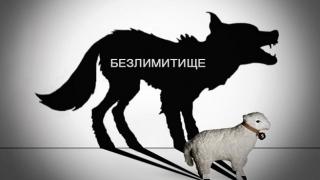DVB-S2 - Digital Video Broadcasting - Satellite
DVB-S standard 2. Digital TV broadcasting system.
Second generation system standard ( DVB-S2) for video broadcasting, interactive services, news gathering and other broadband satellite (SAT) applications is a complement to the widely used SAT standard. broadcasting DVB-S. The new standard was developed by the consortium DVB Project (Digital video Broadcasting Project - the project of digital video broadcasting - an organization that develops standards in the field digital television for Europe) and is technically researched in detail by the Joint Technical Committee of the European Broadcasting Union (RBU), the European Committee for Electrotechnical Standardization CENELEC and the European Telecommunications Standards Institute (ETSI).
Main characteristics of DVB-S2
DVB-S2 is a second generation DVB specification for broadband SAT applications, based on proven DVB-S and DVB-DSNG (Digital Satellite News Gathering) technologies. DSNG is usually understood as mobile systems for transmitting TV information from the scene, called news gathering systems. The DVB-S2 system was developed mainly for:
- standard definition TV broadcast (SDTV) and high definition TV (HDTV or HDTV) services;
- interactive services, including Internet access;
- professional applications.
Rice. 1 LDPC coding rate
For all of these applications, DVB-S2 uses the latest advances in both modulation and channel coding to increase throughput about 30% or more in comparison with DVB-S. A wide variety of adaptive coding, modulation, and error protection levels (ie, coding rates) can be used within the transmitted data stream. Through the reverse channel (and this can be any physical channel, including telephone lines) informing the transmitter of the actual receiving conditions, transmission parameters can be optimized for each individual user in point-to-point broadcasting.
To achieve a compromise between radiated power and spectral efficiency, DVB-S2 provides an extended number of coding rates (1/4, 1/3, 2/5, 1/2, 3/5, 2/3, 3/4, 4 / 5, 5/6, 8/9 and 9/10) at different formats modulation (QPSK, 8PSK, 16APSK and 32APSK). Thus, coding rates 1/4, 1/3 and 2/5 were introduced to work in combination with QPSK modulation for the worst communication conditions, when the signal level is below the noise level (Fig. 1).
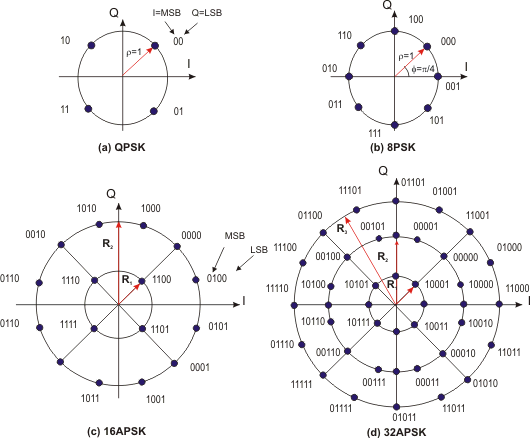
Fig 2.
The QPSK and 8PSK formats are offered for broadcast applications and can be used in near-saturation SAT transponders. 32APSK format provides linear mode operation of the transponder and requires increased values C / N, which is why it is mainly used for professional applications, although it is the most broadband. The 16АPSK format with limited requirements for the linearity of the transponder (special predistortion schemes are used) can find wide range applications, including TV broadcasting. Constellations 16АPSK and 32АPSK are optimized for work on a nonlinear transponder by placing points on circles (Fig. 2). However, their linear channel performance is compatible with the traditional 16 QAM and 32 QAM formats, respectively.
Due to the choice of modulation constellation and coding rates, Ru spectrum efficiencies of 0.5 to 4.5 bps / Hz are available (see Fig. 1). DVB-S2 provides three spectral rounding factors (roll-off factor): α = 0.35 (as in DVB-S), α = 0.25 and α = 0.2 (approximation to a rectangular shape), which additionally increases the throughput, although it presents b O Greater requirements for the linearity of the transponder.
System executions DVB-S2
The DVB-S2 system can be used in “single carrier in transponder” or “multi-carrier in transponder” configurations (using FDM - frequency multiplexing). Obviously, with a single carrier, the symbol rate Rs will correspond to the bandwidth of the transponder (BW = Rs). If there are several carriers, Rs will correspond to the allocated frequency range of this service. The maximum number of services provided will be limited both by the transponder band and the required speed of each of the services provided, and acceptable level mutual interference between adjacent carriers.
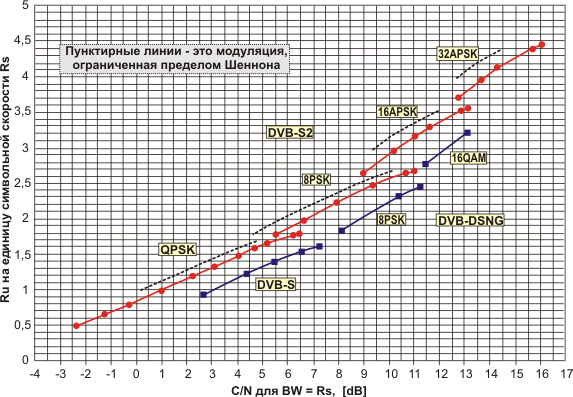
Rice. 3
Single carrier, depending on the selected coding rate and modulation constellation, the system can operate at C / N from -2.4 dB (using QPSK 1/4) to 16 dB (using 32APSK 9/10). The calculation results are modulated on a computer (Fig. 3) for a packet error probability of 10 -7 as for DVB-S2. and for DVB-S / DVB-DSNG, and correspond to approximately one erroneous packet of TS information per hour of TV service transmission at a speed of 5 Mbit / s. With a traditional channel with Gaussian noise, the increase in throughput is 20-35% in comparison with DVB-S and DVB-DSNG under the same transmission conditions, or an improvement of 2 ... 2.5 dB in reception conditions with the same spectrum efficiency Ru.
Figure 4 shows the spectral efficiency of DVB-S2 for a constant SAT bandwidth BW = Rs α ) with a Gaussian noise channel with ideal demodulation. The curves in Figure 4 do not take into account the degradation expected at satellite channel due to a change in the shape of the signal spectrum, due to a decrease in the roll-off factor ( α ). For DVB-DSNG accepted α = 0.35, as the worst case (possibly α = 0,25).
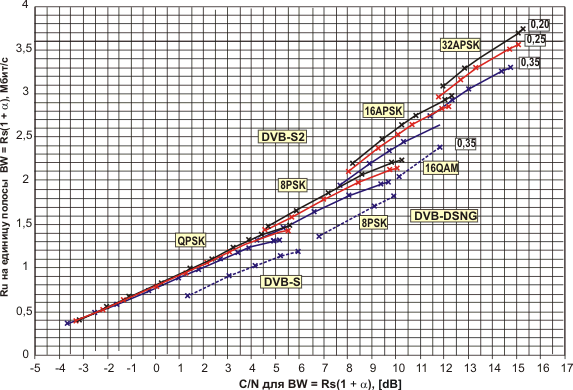
Rice. 4
For APSK modes (i.e. with amplitude and phase modulation), predistortion is possible on the receive side, which allows the SAT amplifier stage to be used in a mode close to saturation, thereby increasing output power, which is especially important for 32 APSK mode. For such cases, special professional low-noise converters (LNC) are used, the price of which is higher than for household converters.
With multiple carriers in the repeater configuration, the introduction of the predistortion scheme does not bring the desired result for any of the modulation schemes. Based on this, it is necessary to reduce the output power of the transmitter (i.e. to work in a quasi-linear mode), as a result of which the realized C / N value also decreases.
Reverse compatible modes, are defined by the DVB-S2 standard in one satellite communication channel for two information TS. The first stream (high priority - HP) is compatible with both DVB-S and DVB-S2 receivers. The second stream (with low priority - LP) is compatible only with DVB-S2 receivers. The presence of two streams is caused by the inevitability of the presence of a rather long transition period from DVB-S to DVB-S2 due to the large number of already used DVB-S receivers... Only at the end of the migration period, when full modulation of DVB-S2 receivers is observed, the emitted signal can be changed to incompatible with reverse direction mode, thus exploiting the full potential of the DVB-S2 bandwidth. Reverse direction compatibility can be achieved using two technologies:
ü With multilevel modulation in asynchronous mode. This operating mode is traditional for any HF channel, which is why it was not reflected in the DVB-S2 specification. Wherein DVB-S signal transmitted to much more high level power versus DVB-S2. Since the resulting combined signal undergoes significant amplitude changes in the envelope, it must be transmitted on a quasilinear transponder, i.e. in a mode far from saturation. Alternatively, with the aim best use SAT power sources, HP and LP signals can be amplified by independent satellite amplifiers (HPA) operating near saturation. The resulting signals are then summed on the downstream channel. However, this approach requires the development and launch of new generation satellites.
ü Hierarchical modulation, in which two HP and LP information TSs are synchronously combined at the symbol level modulation in a non-uniform 8PSK constellation. Since the resulting signal in this case will have a quasi-constant envelope (no amplitude modulation), then it can be transmitted on a single transponder operating near saturation. This solution is included in the DVB-S2 standard as an option.

Rice. 5
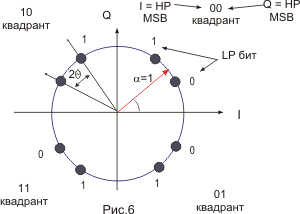
Hierarchical modulation, provides for the use of two parallel channels (Fig. 5): DVB-S and DVB-S2. On the second channel (LP - low priority), the constellation dimension is increased to an uneven 8PSK (Fig. 6). Of all the possible configurations of a DVB-S2 stream, only the normal FEC frame configuration with 64 800 bits (720 slots × 90 bits) is allowed. The deviation angle q (Fig. 6) can be changed at the request of the user: b O larger angles θ improve C / N with respect to LP and lower C / N for HP.
For reference, Table 1 shows the ratio of data transfer rates (in%) LP / HP. The technical report provides a formula for calculating the required C / N LP for a low priority stream:
Table 1
| DVB-S coding (HP) | DVB-S2 coding (LP) | |||
| 1/4 | 1/3 | 1/2 | 3/5 | |
| 1/2 | 26,6 | 35,7 | 53,7 | 64,6 |
| 2/3 | 20 | 26,7 | 40,3 | 48,4 |
| 3/4 | 17,8 | 23,8 | 35,8 | 43 |
| 5/6 | 16 | 21,4 | 32,2 | 38,7 |
| 7/8 | 15,2 | 20,4 | 30,7 | 36,9 |
table 2
| Mode | Spectral efficiency | Ideal Es / No (dB) for 64 800 bit FEC frame |
| QPSK 1/4 | 0,49 | -2,35 |
| QPSK 1/3 | 0,66 | -1,24 |
| QPSK 2/5 | 0,79 | -0,3 |
| QPSK 1/2 | 0,99 | 1 |
| QPSK 3/5 | 1,19 | 2,23 |
| QPSK 2/3 | 1,32 | 3,1 |
| QPSK 3/4 | 1,49 | 4,03 |
| QPSK 4/5 | 1,59 | 4,68 |
| QPSK 5/6 | 1,65 | 5,18 |
| QPSK 8/9 | 1,77 | 6,2 |
| QPSK 9/10 | 1,79 | 6,42 |
| 8PSK 3/5 | 1,78 | 5,5 |
| 8PSK 2/3 | 1,98 | 6,62 |
| 8PSK 3/4 | 2,23 | 7,91 |
| 8PSK 5/6 | 2,48 | 9,35 |
| 8PSK 8/9 | 2,65 | 10,69 |
| 8PSK 9/10 | 2,68 | 10,98 |
| 16APSK 2/3 | 2,64 | 8,97 |
| 16APSK 3/4 | 2,97 | 10,21 |
| 16APSK 4/5 | 3,17 | 11,03 |
| 16APSK 5/6 | 3,3 | 11,61 |
| 16APSK 8/9 | 3,52 | 12,89 |
| 16APSK 9/10 | 3,57 | 13,13 |
| 32APSK 3/4 | 3,7 | 12,73 |
| 32APSK 4/5 | 3,95 | 13,64 |
| 32APSK 5/6 | 4,12 | 14,28 |
| 32APSK 8/9 | 4,4 | 15,69 |
| 32APSK 9/10 | 4,45 | 16,05 |
Figure 7 shows the required C / N for HP and LP flows depending on the angle θ for non-uniform 8PSK constellation at various coding rates. Short dots in Fig. 7 indicate the boundaries of the reverse channel mode realization. In fact, with increasing angle θ , the constellation becomes more similar to the standard 8PSK (Figure 2). The above calculations are performed for the worst case ( α = 0.2) at symbol rate at 20 Mbaud.
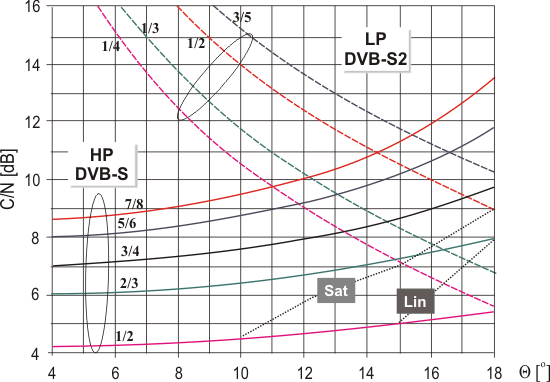
Rice. 7
Our company "Kontur-M" will send to interested readers a program (Excel) for calculating C / N and bit rates.
Adaptive Coding and Modulation (AFM) is the “highlight” of DVB-S2. This mode of operation is applicable for point-to-point applications (point-to-point applications, for example, IP broadcast to one address or DSNG). The essence of the AFM mode is that depending on the signal reception (for example, the presence of rain), the operating mode of the DVB-S2 modulator changes, i.e. the coding rate (SR) and the modulation format change, as a result of which the required C / N is required from the subscriber. Simply put, the AFM mode allows you to achieve maximum speed digital stream for all weather conditions. The C / N threshold is set on the receiving side by the consumer of this service (Fig. 8) by continuously measuring C / N + I (carrier-to-noise ratio + interference) and sending the measured value to the broadcast terrestrial transmitting station via the reverse channel. In this case, the coding and modulation parameters can change from frame to frame.

Rice. eight
In order to avoid overflow of received information during poor reception conditions (SR is lowered), a mechanism for controlling the rates of information streams is established. In other words, automatic adaptation is carried out useful traffic to the physical capabilities of the channel. A critical issue in AFM systems is the time lag in the adaptation loop. physical layer as it is directly related to system capability tracking channel state changes. So, significant time delays can lead or to the loss of some frames with a sharp deterioration in the signal path (bad weather, usually it is not more than 1 dB per second) or to the loss of potential channel bandwidth. A deliberate increase in the protective threshold of the AFM system (by analogy with AGC) will lead to the economic inexpediency of its use.
Note that the mechanism of operation of the ACM system is rather complicated, especially at the subsystem level for supporting ACM with MPEG-TS (for example, multiplexing audio, video, multimedia and IP streams with CBR and VBR), where zero packets are added and removed with the formation of CBR ( TS with constant speed). But, in spite of all the complexity of the AFM system, depending on the parameters of the communication line and its configuration, it can increase the throughput up to 200% in comparison with CCM (constancy of coding and modulation).
DVB-S standard. Satellite (SAT) TV broadcasting has been and remains the fastest, most reliable and cost-effective way of delivering high quality TV signals anywhere in a wide area.
All broadcast artificial satellites Lands (AES) are located on the so-called geostationary orbit(GO) - a circular orbit with an altitude of ~ 36000 km in the equatorial plane. Being on the GO, the satellite is motionless relative to the Earth's surface, because rotates at the same angular velocity as the Earth. The visibility zone of a geostationary satellite is about one third of the earth's surface.
For SAT broadcasting, special sections of the radio frequency spectrum in the centimeter wavelength range are allocated, where an increased power flux density from the satellite is allowed. The most developed section of the K U-band with frequencies of 11.7 ... 12.5 GHz. The broadcast power of the satellite at a given point of reception is usually characterized by the equivalent isotropically radiated power (R EIRP), which is the product of the output power of the satellite transmitter and the gain of the transmitting antenna in this direction... P EIRP is usually expressed in dBW (dBW) and is usually 45… 60 dBW. In the adjacent ranges 10.7 ... 11.7 GHz and 12.5 ... 12.75 GHz, satellites of the so-called fixed satellite service with typical values of R EIRP 38 ... 52 dBW broadcast.
One of the features of the use of satellites is the limited energy potential of the satellite repeater, due to which SAT broadcasting traditionally uses processing methods that require a minimum carrier-to-noise ratio (C / N) at the demodulator input in exchange, for example, for the signal frequency band. V analog broadcasting it was a choice frequency modulation(instead of analog), and in digital broadcasting one has to use powerful cascade noise-immune coding and modulation with low folds (for example, QPSK instead of the higher-speed 16 QAM). Additional feature digital SAT broadcasting is the fact that multi-program broadcasting is carried out due to multiplexing in a digital stream, and the operation of the satellite transmitter is carried out only on one carrier in a non-linear mode, which allows increasing its output power by 2.5 ... 4 dB. Such an increase in energy is equivalent to a 2-fold decrease in the diameter of the reflector of the receiving antenna in comparison with the reception of analogue broadcasting signals.
In 1994. within the consortium DVB Project was created European standard satellite digital system multi-program TV broadcasting is a DVB-S standard operating in the 11/12 GHz frequency band (European Standard EN 300 421 v.1.1.2, 1997-08). For the purposes of SAT broadcasting, frequency bands are allocated in the 12, 29, 40 and 85 GHz bands. In the 40 GHz and 85 GHz bands, a frequency spectrum of 2 GHz is allocated.
In October 1996. the draft Recommendation on General functional requirements to the multi-program SAT broadcasting systems in the 11/12 GHz frequency band, and already in October 1999. a project was developed new Recommendation, taking into account that there are four systems similar in architecture in the world: DVB-S standard (System A), DSS (System B), G1-MPEG-2 (System C) and ISDB-S (System D).
System A (DVB-S standard) was developed by the European consortium DVB Project and is designed to deliver multi-program TV broadcasting or HDTV services to frequency ranges fixed and broadcasting SAT services (10.7 ... 12.75 GHz) with their direct reception on integrated home receiver-decoders, as well as on receivers connected to systems with SAT collective TV antennas SMATV (Satellite Master Antenna TV), and systems cable TV(SKT) in the primary and secondary distribution of TV broadcasting programs. At present, almost all digital SAT TV broadcasting to all five continents is carried out according to the DVB-S standard.
There are two main ways digital transmission SAT signals:
- transmitting N compressed digital signals on N carriers;
- multiplexing N compressed digital signals and transmitting them on a single carrier.
The number of TV broadcast programs that can be broadcast with one satellite transponder depends on the required bit rate, component or composite coding format for the signal source, the quality and resolution of the original image, the criticality of the compression algorithm to some types of images and the required quality of the reconstructed image.
Advances in data compression make it possible to organize a large number of digital high-quality TV channels with relatively low speeds(less than 1 Mbps, which is equivalent to 20-25 TV channels in a standard SAT channel bandwidth of 27 MHz). In many cases, a speed of 400 kbps is acceptable, which is equivalent to at least 60 TV channels from one transponder.
Block diagram of the transmitting part of the DVB-S standard
On the transmitting side, the following transformations of the data stream are performed to adapt it to the channel:
- transport multiplexing and randomization for energy dispersion;
- external coding with Reed-Solomon (RS) code;
- convolutional interleaving and intracoding using a punctured convolutional code;
- signal shaping in the baseband and its modulation.
SAT TV broadcasting systems are characterized by limited power transmitted signal and therefore hypersensitivity to the effects of noise and interference. Sharing energetically effective quadrature phase modulation QPSK and concatenated coding for a channel based on a shortened RS code and a convolutional code in combination with a soft-decision Viterbi decoding algorithm provides a high noise immunity of the system under conditions of noise and interference interference, as well as nonlinearity of an on-board repeater (i.e., the ability to work with increased power). With consistent filtering and forward error correction, high quality admission is achieved even in extreme conditions when the minimum signal level is close to the values corresponding to the threshold values of the carrier-to-noise (C / N) and carrier / interference (C / I) ratios. In this case, no more than one error per hour is guaranteed, which is equivalent to the error probability of about 10 -10 ... 10 -11 at the input of the MPEG-2 demultiplexer in the receiver-decoder.
To match the transmitted signal with the bandwidth and energy characteristics of a specific transponder, the required ratio BW / R s is set, where BW is the transponder bandwidth at a level of - 3 dB, R s is the speed transmitted characters... So, for QPSK modulation, convolutional code rate R and RS code rate 188/204, the corresponding information symbol transmission rate will be:
R U = R (2R s) (188/204) = 1.843 R R s.
For a given symbol rate R s, one of 5 values of the coding rate of the inner convolutional code can be selected, which accordingly changes the received symbol rate RU and the spectral efficiency of the system C U = R U / BW. Possible options the ratio of the transmission rates R, R s, R U and the efficiency C U from the transponder bandwidth at BW / R s = 1.28 for QPSK modulation are given in Table 1.
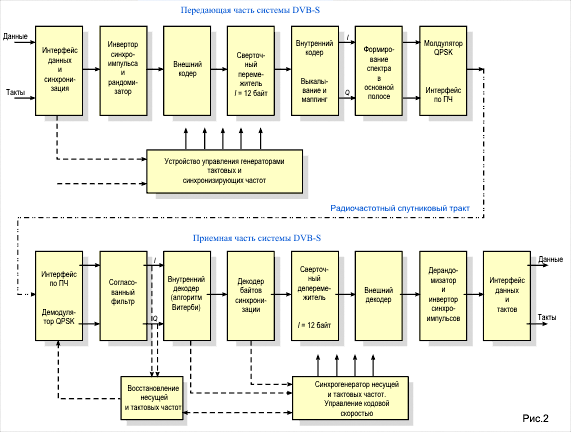
| BW, MHz | Rs, Msim / s | R = 1/2 | R = 2/3 | R = 3/4 | R = 5/6 | R = 7/8 | |||||
| R U, Mbps | With U, bit / (cHz) | R U, Mbps | With U, bit / (cHz) | R U, Mbps | With U, bit / (cHz) | R U, Mbps | With U, bit / (cHz) | R U, Mbps | With U, bit / (cHz) | ||
| 54 | 42,2 | 38,9 | 0,72 | 51,8 | 0,96 | 58,3 | 1,08 | 64,8 | 1,2 | 68 | 1,26 |
| 46 | 35,9 | 33,1 | 0,72 | 44,2 | 0,96 | 49,7 | 1,08 | 55,2 | 1,2 | 58 | 1,26 |
| 40 | 31,2 | 28,8 | 0,72 | 38,4 | 0,96 | 43,2 | 1,08 | 48 | 1,2 | 50,4 | 1,26 |
| 36 | 28,1 | 25,9 | 0,72 | 34,6 | 0,96 | 38,9 | 1,08 | 43,2 | 1,2 | 45,4 | 1,26 |
| 33 | 25,8 | 23,8 | 0,72 | 31,7 | 0,96 | 35,6 | 1,08 | 39,6 | 1,2 | 41,6 | 1,26 |
| 30 | 23,4 | 21,6 | 0,72 | 28,8 | 0,96 | 32,4 | 1,08 | 36 | 1,2 | 37,8 | 1,26 |
| 27 | 21,1 | 19,4 | 0,72 | 25,9 | 0,96 | 29,2 | 1,08 | 32,4 | 1,2 | 34 | 1,26 |
| 26 | 20,3 | 18,7 | 0,72 | 25 | 0,96 | 28,1 | 1,08 | 31,2 | 1,2 | 32,8 | 1,26 |
Block diagram of adaptation blocks to the DVB-S standard channel on the transmitting and receiving parties are shown in Fig. 2. As noted above, the main type of modulation in the DVB-S standard is QPSK (sometimes referred to as FM-4 in the domestic literature), although in some cases 8 PSK (FM-8) and even 16 QAM (KAM-16) can be used. The use of error-correcting coding makes it possible to significantly reduce the ratio E b / N 0 required for the operation of a demodulator with QPSK (the ratio of the energy in one byte of information to the noise power, see Fig. 3), and for modulation with a greater multiplicity, the threshold value E b / N 0 turns out to be somewhat above (Table 2) .9
We did not have time to finally pass from analog television on the digital standards television broadcasting DVB - satellite DVB-S, terrestrial DVB-T and cable DVB-C- as their new versions have already appeared, DVB-S2, -T2 and -C2. What are the differences between the new standards and the previous ones, how expedient is their use, and how widespread will they be in the future?
Known to be the subject of attention DVB standards-S, -T and -C are methods of physical data transmission over satellite, terrestrial and coaxial cable television networks respectively. The goal of any of these three standards is to reliably transmit a stream of data, regardless of what exactly is encoded in that stream. As a rule, a data stream carries several television and radio channels, but theoretically it can be used to transmit any other information to digital form, because the DVB-S, DVB-T and DVB-C standards have nothing to do with what is inside the stream. And already how several channels of audio and video will be combined into one data stream, what kind of codecs they are encoded, etc. - all this is determined by completely different specifications (both DVB family standards and other generally accepted technologies like MPEG). As a result of this unification building blocks digital television technologies are becoming interchangeable: for example, the same video data stream can be transmitted both by satellite and over the air and cable networks, both of the first generation (DVB-S, DVB-T, DVB-C) and the second (DVB-S2, DVB-T2, DVB-C2).
Since the standards we are considering are nothing more than a "pipe" for transmitting data streams, then the differences between the second generation of these standards from the first, of course, are mainly in the increased thickness of this "pipe". WITH technical point view, they have two key innovations: a richer set of modulation methods digital signal and more advanced error correction algorithms. High modulation orders allow, by saying in simple words, place more characters per second on the same radio waves, and a new one, almost perfect algorithm error correction will allow information to be transmitted with much less redundancy than before.
Since the frequency resource, as a rule, has a very real price in monetary terms, we can say that when using the second generation DVB standards, each megabit transmitted information costs at least 30% less. And what is most interesting, in cases where there is no need to replace old equipment with new ones (i.e., when introducing new service, which does not already have an established subscriber base), such savings can be obtained practically free of charge. If, for example, the cost receiving equipment with support for MPEG-4 compared to MPEG-2, or equipment of normal definition and HD, may differ significantly, then, for example, the price of a DVB-T2 standard receiver will be only a couple of dollars more than the price of the same receiver (with the same video decoding capabilities), but capable of receiving only regular DVB ‑ T. Absolutely the same applies to DVB-S2 with DVB-C2, and this difference in price will constantly decrease down to zero.
We all faced the fact that satellite receivers DVB-S2 are many times more expensive today receivers DVB-S... But such a difference is determined only by the fact that along with the possibility of receiving DVB-S2, it is customary to implement the ability to decode MPEG-4 video format, and it is this function that makes the entire device more expensive. And, for example, in devices offered on the Ukrainian market DVB-T support MPEG-4 is already available, and therefore the addition of DVB-T2 reception capability will hardly increase the cost of such devices.
By the way, the most interesting aspect of the second generation of DVB physical layer standards is their perfection ... literally! Surprising but true: DVB-S2, DVB-T2 and DVB-C2 standards have come so close to theoretical limit efficiency of information transfer (Shannon border) that the third generation of these standards will probably never be. This means that they are likely to remain unchanged until the very idea of one-way broadcasting of a fixed-width information stream loses its relevance. Whatever new methods of image transmission appear (including 3D TV surround), new video and audio codecs - the data encoded by them will still be transmitted via DVB ‑ S2, DVB ‑ T2 and DVB ‑ C2 as long as the traditional television in the form in which we are used to seeing it will not be completely supplanted by some distant descendant of what we call IPTV today.
Well, what about the near future? How fast will the transition to the "second" standards be? It will not be possible to give a general answer to this question: the expediency of such a transition very much depends on certain factors, the main of which is the presence or absence of already installed client equipment of the old model, because for migration to new standard all receiving equipment have to be replaced.
DVB-S2
The satellite DVB-S2 standard was the very first of the second generation of DVB standards, and therefore the process of its implementation to date has advanced much further than others. The emergence of DVB ‑ S2 coincided in time with the emergence of a real market (rather than experimental) HDTV, as well as with the large-scale introduction of the MPEG-4 AVC video compression standard, as a result of which DVB-S2 has actually become a mandatory format for all satellite HDTV broadcasts. As you know, the MPEG-4 video compression format can be used not only for high-definition video signal: when converting a normal resolution channel to this format, you can save almost half of the bandwidth it occupies, and if you add another 30% from DVB-S2 to this saving, then the result is too tempting to be neglected. Thus, the expediency of using the good old DVB-S and MPEG-2 for new satellite operators, not burdened by a fleet of old equipment, disappeared very quickly. A striking example is the Ukrainian Viasat, which, thanks to the use of modern standards was able to launch a full-fledged DTH platform in 2008 with only two transponders.
Satellite operators "with experience", already overgrown with a solid subscriber base with old client equipment, such as Russian NTV Plus and Tricolor, also do not sit still and have already begun to implement plans to gradually transfer all their subscribers to DVB-S2 with MPEG-4 ... And although some Russian and Ukrainian operators still offer their new subscribers DVB-S2 / MPEG-4 receivers without the ability to receive HDTV, high-definition television will definitely become an incentive for the migration of old subscribers to the new standard. It is easy for subscribers to understand that in order to watch HDTV, the new standard of television, they need to upgrade their equipment, and such an upgrade will be perceived by them absolutely harmoniously. Thus, end users will not have to think about the differences between DVB-S and DVB-S2 at all.
In general, we can say that today the turning point of the transition to DVB-S2 has already been left behind. Equipment unable to receive satellite signal in this standard, is already perceived as an endangered species, and almost every satellite TV operator in the world has already developed a plan for a gradual transition to DVB-S2 with MPEG-4. And are there any other arguments needed if all three Ukrainian operators of pay satellite TV initially use this standard as the main one?
DVB-T2
Due to the fact that terrestrial DVB-T2 appeared much later than its satellite counterpart, its support is currently not present in every device capable of decoding MPEG-4 SD and even HD. Undoubtedly, this situation is temporary: it is DVB ‑ T2 that is considered in Western European countries as an unambiguous standard for terrestrial HDTV. And although in this moment HD test broadcasts in regular DVB-T are in progress in some areas, and regular HD broadcasts in Europe are expected to be broadcast exclusively in DVB ‑ T2. The fact is that the use of DVB-T2 for high definition television is key element long-term strategy for transferring everything to it digital broadcasting: sooner or later, every viewer, regardless of his income level, will be able to watch HDTV, and if any HD receiver supports DVB-T2, then this will make it possible to transfer standard definition channels to it, which, in turn, will free up space for additional channels HDTV.
It is important to understand that a country whose regulators miss out on the opportunity to do DVB-T2 mandatory standard for terrestrial HD, will radically complicate the transition to this standard in the future. This is very important point, which must be taken into account in Ukraine as well. It is already obvious that the need to switch to DVB-T2 at some point will inevitably arise, and after all, to explain to the population that after a certain date only high-definition TVs will continue to work, it is much easier than changing the physical broadcasting standard simply in order to expand the network capacity. And if someone believes that high-definition television will continue to be a premium product, then he should be reminded of how only 15 years ago mobile phones only fabulously rich people could use, and today even representatives of the poorest strata of the population cannot do without them.
DVB-C2
As for cable standard DVB-C2, the prospects for its use are far from being as bright as those of its satellite and terrestrial counterparts. The main problem is that DVB-C2 was born too late, much later than the moment of transition of most DVB-C cable networks to HDTV - the moment when it was painless to do it. required element every modern cable receiver... And since in cable networks acute problems with the frequency resource usually do not arise, it would be completely pointless to make any sacrifices for the sake of saving frequencies. And although DVB-C2 cannot be called completely stillborn - in certain cases there is still a use for it - the DVB-C2 standard will most likely never have such unconditional domination, which DVB-S2 is already beginning to use and which is unanimously predicted for DVB-T2.
If you find an error, please select a piece of text and press Ctrl + Enter.


